In this post you are going to learn the best cold email campaign guide and create effective cold emails. Learn to write personalized messages that get results and build connections!

Table of Contents
What is a Cold Email?
A cold email is a message sent to people who have never interacted with you or your business before. It’s used to reach new clients, generate leads, network, or explore partnerships. Unlike spam, cold emails are personalized and targeted. The goal is to start a conversation, offer value, and turn the recipient into a customer or lead.
For further reading on crafting personalized emails, check out our guide on Cold Email Strategy
How to Start Your First Cold Email Campaign?
Starting your first cold email campaign may seem challenging, but by following a few simple steps, you can set yourself up for success.
1. Build a Targeted Prospect List
The foundation of any cold email campaign is a well-researched list of potential leads. Use tools like LinkedIn Sales Navigator or Hunter.io to gather relevant prospects. Ensure that your list targets the right audience, who will benefit from your product or service.
If you’re curious about how many emails it takes to land a client, see our analysis on How Many Cold Emails To Get One Client
2. Choose Cold Email Software
Cold email software like Mailshake or Lemlist can help automate the process. These tools allow you to personalize, schedule, and track email performance, giving you insight into what’s working and what needs improvement.
3. Set Up a Professional Domain
Using your primary domain for cold emails can harm its reputation. Instead, purchase a separate domain for outreach. Ensure the domain is relevant to your brand, easy to remember, and properly authenticated with SPF, DKIM, and DMARC to avoid spam filters.
4. Warm Up Your Email Address
Start by sending a small number of emails to trusted contacts, gradually increasing the volume. This builds a positive sender reputation and avoids triggering spam filters.
For tips on avoiding blacklisting while sending bulk emails, check out our blog on Sending Bulk Cold Emails Without Getting Blacklisted
5. Craft a Compelling Email
Personalization is key. Address recipients by name, keep the message concise and focus on solving their pain points. Use a clear call to action (CTA) to encourage replies or further engagement.
6. Monitor and Optimize
Track the open rates, click-through rates, and responses. Use A/B testing to optimize subject lines and content for better results.
If you want to dive deeper into optimizing for responses, explore our Cold Email Response Rate Guide.
How to Build a Quality Email List for Cold Outreach?
Building a quality email list for cold outreach is key to a successful campaign. Follow these four simple steps to get started:
1. Research Your Ideal Customer Profile (ICP)
Start by identifying your ideal customer. Know their industry, job role, company size, and problems they face. This helps you focus on the right leads who are more likely to respond.
2. Organize and Segment Your Leads
Once you know your target audience, collect and organize your leads. Use tools like LinkedIn or lead generation software to find potential contacts. Then, group them based on factors like location or job role to make your emails more personalized.
3. Use Lead Finding Tools
Tools like ZoomInfo, Apollo.io, or Hunter.io can help you quickly find leads. These tools provide verified email addresses, making sure your emails reach the right people.
4. Verify and Clean Your List
Before sending emails, use verification tools like NeverBounce or ZeroBounce to clean your list. This ensures your emails are delivered to inboxes and not marked as spam.
Best Tools to Improve Your Cold Email Campaigns
Cold email campaigns are a powerful way to connect with new prospects, but using the right tools can make all the difference in achieving success. Here are some of the best tools to enhance your cold email outreach:
1. Lemlist
Lemlist offers strong personalization features, including adding dynamic content to images. It also provides a warm-up tool, helping you boost your sender reputation.
2. Woodpecker
Woodpecker offers automated email sequences, A/B testing, and personalization options. It also includes email warm-up features and deliverability monitoring to ensure your messages reach the recipient’s inbox.
3. Snov.io
This tool focuses on lead generation and bulk email verification. It allows you to personalize emails and create automated sequences. While it lacks a built-in email warm-up feature, Snov.io is a strong choice for smaller teams.
4. Reply.io
Reply.io provides email validation and A/B testing, helping you optimize your campaigns. Its personalization and automation features allow you to reach prospects effectively. The tool also integrates with CRMs like Salesforce and HubSpot.
5. Mailshake
Known for its simplicity, Mailshake offers email automation and follow-ups. It allows you to personalize your outreach with custom fields and integrates well with other sales tools for seamless tracking.
How to Write an Effective Cold Email That Actually Works?
Cold emails are a powerful tool to start business relationships, but crafting one that gets a response can be challenging. An effective cold email is short, personalized, and focused on the recipient’s needs rather than pushing a product. Let’s break down the steps to write a cold email that works:
1. Start with a Strong “From” Line
Your “from” line is the first impression. Use a simple and personal approach like your first name and company (e.g., “Nayna from Neighbor Glass”). This builds trust and familiarity.
2. Write an Eye-Catching Subject Line
A good subject line piques curiosity without sounding spammy. Use personalization and relevance, such as, “{{First Name}}, here’s a way to improve {{Company}}’s sales process.” Keep it concise and related to their interests.
3. Grab Attention in the Introduction
In the first two sentences, focus on the recipient, not yourself. Mention something specific about their work or achievements to show you’ve done your research.
For example, “I saw your recent blog post about growing sales in the healthcare sector, and I think we can help you scale that.”
4. Present a Value-Focused Pitch
Your pitch should revolve around how you can solve a problem for them. Focus on benefits, not features.
Instead of saying, “Our CRM has these features,” say, “We help companies like yours streamline customer management to increase efficiency by 30%.”
For more tips on writing compelling emails, take a look at our 5 Cold Email Writing Tips
5. End with a Clear Call to Action (CTA)
Make your CTA simple and actionable. Instead of requesting a long meeting, ask for something easier like, “Would you be open to a quick 10-minute chat next week to explore this further?”
6. Include a Polished Signature
Your signature should provide contact details and links to more information about you or your company. Make it clean and simple, with relevant links and social profiles, ensuring it supports your credibility.
Conclusion
Starting a cold email campaign is easy and can be very effective. First, write a personalized message that focuses on what your recipient needs. Be sure to include a clear call to action.
If you’re in a high-ticket B2B space like recruitment agencies, financial advisory, manufacturing companies, SaaS businesses, and M&A professionals then building a cold email list is not optional—it’s essential.
Always test your emails and improve based on the results. With good planning and ongoing adjustments, your cold email campaign can create valuable connections and lead to success.


